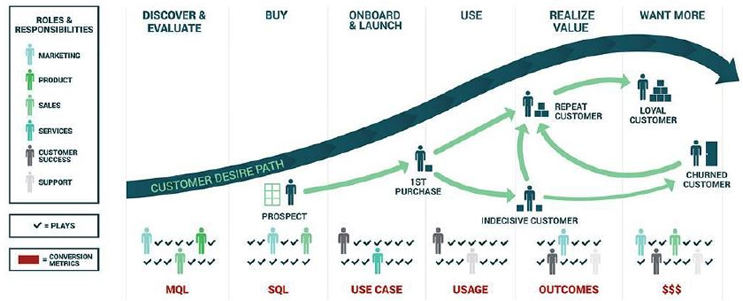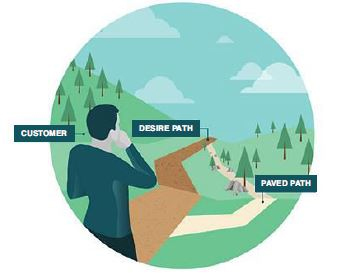Keep The Revenue Your Company Worked So Hard To Earn
By Kia Puhm
If you follow the path customers naturally take, not the one you outline, the result will drive customer adoption, loyalty, and expanded product use.
 Customer behaviors are changing. Expectations have grown, and customers demand great experiences at all touch points, putting increasing pressure on both B2B and B2C businesses. Services and products are no longer differentiators in why customers buy; the customer experience companies provide is. According to Forrester, companies focused on their customer experience (CX) outperform competition by 14 percent, compounded annually.
Customer behaviors are changing. Expectations have grown, and customers demand great experiences at all touch points, putting increasing pressure on both B2B and B2C businesses. Services and products are no longer differentiators in why customers buy; the customer experience companies provide is. According to Forrester, companies focused on their customer experience (CX) outperform competition by 14 percent, compounded annually.
Most organizations recognize the importance and value of good CX, but are struggling to deliver it. A disconnect exists between the CX companies strive to deliver and the way businesses operate to support customer needs and expectations. The problem is that companies are run according to their internally defined, company-centric viewpoints, which typically neglect to consider the customers’ perspectives and what would make for a natural and seamless product adoption experience. By forcing customers to conform to their procedures, companies produce customer experiences in siloes disconnected from customer expectations. Companies are inadvertently creating poor customer experiences and making it harder for their customers to adopt products and services.
Software vendors need to understand what the most comfortable and relevant success paths are for their customers (from the customers’ perspectives) and then create corresponding repeatable, prescriptive, and scalable approaches for driving greater adoption experiences. If the adoption, retention, and expansion journeys for customers are as natural as possible, they will be more successful at using the products and services and quicker to recognize the value they are realizing from them. How to consistently deliver a good CX, and in a manner that is most effective for the business, is thus about the company codifying its customers’ success paths into operational models that prescriptively manage customers through repeatable customer journeys.
Companies that operate in a customer-centric fashion learn, through regular observation of the journeys, how to adapt to and anticipate the changing needs of their customers, which drives improved adoption and CX. They also stay ahead of potential disruption by evolving operations as customers’ needs change. As a result, customers receive superior customer experiences and the value they anticipated and desired, not only when they purchased the product or service, but continuously afterward, as customers.
THE CUSTOMER JOURNEY AS THE PATH TO SUCCESS
The customer journey is the foundation of a customer-centric approach. It leverages the aggregated understanding of the customer base to define the ideal path to success. It facilitates the alignment of people, processes, and technology to most efficiently, proactively, and holistically support customers through their life cycles. It informs how to manage customers through to successful adoption and help them use technology on their own terms.
Customarily, companies use customer journey mapping as an exercise to improve the CX. This involves illustrating the stages customers go through from presale to becoming customers. It was first used in marketing to understand interactions prospects had with the brand in order to identify relevant messaging and assist in the buying process. The mapping did not extend much further past the traditional sales and marketing funnel.
However, the customer journey can and should be used to understand and map the entire success route customers follow in achieving their desired outcomes. From a postsales perspective, a vendor can gain insights from its most successful customers and outline their journeys from their points of view. In understanding why customers bought the product or service, what they are trying to achieve in using it, and how their companies manage change within their organizations, businesses can think from the customers’ perspectives (not from their own products or businesses’ perspectives). This makes it easier and faster for customers to adopt and use the products or services. By observing the path that the most successful customers have taken to achieve their objectives, an organization can codify a repeatable, prescriptive, and proactive customer journey for all customers to follow.

The image above illustrates a desire path, which is the path that pedestrians prefer to walk on and have created as a result of foot traffic. Land planners purposely leave land unpaved, wait to see what desire paths are created, and then pave those. If a company follows the path its customers naturally take, not the one its organization outlines to its customers, the resulting customer journey path will be the most effective one at driving customer adoption, loyalty, and expanded product use. Thus, revenue increases, and churn is reduced.
BUILDING AN INTELLIGENT FRAMEWORK™
In a customer-centric approach, vendors close the gaps that inhibit customer adoption and expansion to create a seamless experience that is relevant to the customers’ needs and timing. The resulting repeatable success and good experience is what drives loyalty.

A customer-centric model is predicated on an understanding of what the customer needs to be successful, when and how. Once the desired path has been codified, businesses can develop an “Intelligent Framework” that supports every step of the customer journey with the requisite actions and skillsets, measures the progress of customers through the journey, and observes how the framework is serving or hindering customer progress. This is the DesiredPath Intelligent Framework™.
In the model above, the journey outlines the path customers take with an organization as a result of their observed desire paths. The corresponding DesiredPath Intelligent Framework (Playbook, Roles and DesiredPath Metrics™) is completely aligned to the journey in order to maintain customer-centricity. The metrics form the “customer funnel” (the means to measure customer progress).
The customer desire path informs what actions should effectively support customers throughout the journey. Businesses align their operations to drive quick and easy adoption and demonstrate ROI and realized value for retention and a path to further expansion for its customers. There is a narrative for success that allows customers to move through the adoption-retention-expansion journey as seamlessly as possible and the corresponding alignment of the vendor’s people, processes, and technology to support that objective. The resulting desire paths from these successful customers create revenue blueprints as well. Successful customers create successful businesses.
CONCLUSION
The changing landscape of business has created an environment where only customer-centric organizations will survive. Companies must continue to adapt and deliver good experiences to meet the ever-increasing expectations of customers. By using the desire path to successful product adoption and expansion that is most natural to customers, companies can more effectively and efficiently drive their own revenue and success and, ultimately, keep the revenue they worked so hard to earn.
KIA PUHM is a frontierswoman in the SaaS customer success industry, with extensive experience building world-class practices that accelerate business growth. She previously held C-level positions at Oracle, Eloqua, Day Software (Adobe), Intelex Technologies, and Blueprint Software Systems. Based on 24+ years of expertise, she developed the Intelligent Framework™ to provide clients with a disciplined, sustainable, and scalable approach to increasing customer value and long-term loyalty.
